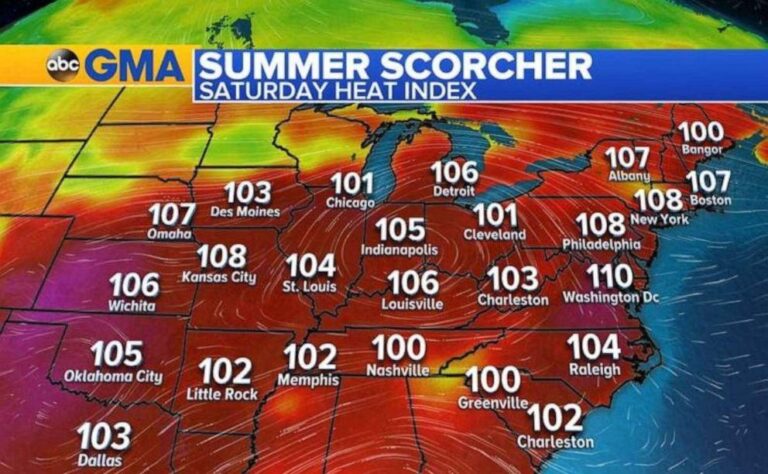As a deadly heatwave continues to scorch the eastern half of the United States, heat indices are expected to reach perilous levels near 120 degrees Fahrenheit, according to weather officials. The sweltering temperatures pose notable health risks and are prompting urgent warnings as millions brace for relentless heat and high humidity. This extreme heat event, driven by stagnant atmospheric conditions, is straining power grids, increasing the potential for heat-related illnesses, and challenging communities from the Southeast up through the Northeast. Authorities are urging residents to take precautionary measures as they navigate the ongoing heat crisis.
Heat Indices Soar to Dangerous Levels Across Eastern States
Residents across the eastern United States are bracing for an oppressive heatwave, with heat indices expected to soar to near 120 degrees Fahrenheit. Meteorologists warn that such conditions amplify the risk of heat-related illnesses, making caution and preparedness essential.Urban areas face heightened challenges due to the “urban heat island” effect, which can push temperatures several degrees higher than surrounding rural zones. Vulnerable populations, including the elderly and those with preexisting health conditions, are urged to stay indoors during peak afternoon hours.
Key precautions to take during this extreme heat include:
- Hydrating frequently with water or electrolyte-replenishing fluids
- Wearing lightweight, loose-fitting clothing
- Limiting outdoor activities, especially during midday
- Checking on neighbors and family members, particularly those who live alone
- Utilizing cooling centers or air-conditioned public spaces when possible
| State | Projected Heat Index (°F) | Safety Advisory Level |
|---|---|---|
| New York | 115 | Extreme Heat Warning |
| Virginia | 118 | Heat Advisory |
| Georgia | 120 | Excessive Heat Warning |
| Pennsylvania | 112 | Heat Advisory |
Health Risks Rise as Authorities Warn of Severe Heat-Related Illnesses
The soaring heat across the eastern United States has prompted health authorities to issue urgent warnings about the potential for serious heat-related illnesses. With heat indices expected to exceed 120 degrees in many areas, the risk of heat exhaustion, heatstroke, and dehydration escalates sharply. Vulnerable populations — including the elderly, children, and those with preexisting health conditions — are especially susceptible. Officials emphasize the need for immediate precautionary measures to mitigate these dangers as temperatures continue their relentless climb.
To safeguard public health amid this extreme weather, experts advise residents to:
- Stay hydrated: Drink plenty of water throughout the day, avoiding alcohol and caffeine.
- Remain indoors during peak heat hours: Limit outdoor activities between 10 a.m. and 4 p.m.
- Utilize air-conditioned spaces: Visit cooling centers or air-conditioned buildings if home cooling is unavailable.
- Wear lightweight, loose-fitting clothing: Opt for breathable fabrics to help body temperature regulation.
| Symptom | Recommended Action |
|---|---|
| Heavy sweating and weakness | Move to a cooler place and hydrate promptly |
| Dizziness or fainting | Lie down, elevate feet, and seek medical help if needed |
| Rapid pulse or confusion | Call emergency services and begin cooling the body |
Communities Mobilize Cooling Centers and Emergency Response Plans
As the relentless heatwave pushes heat indices toward a staggering 120 degrees, local governments and community organizations across the eastern United States are activating crucial resources to safeguard vulnerable residents. Cooling centers are being swiftly set up in public libraries,community centers,and places of worship,offering a refuge from the oppressive heat. Volunteers and officials are working around the clock to ensure these centers are adequately stocked with water, seating, and first aid supplies.
Key measures being implemented include:
- Extended operational hours for cooling centers to accommodate those without air conditioning
- Deployment of mobile hydration units in high-risk neighborhoods
- Emergency alert systems to inform residents about heat-related dangers and precautionary steps
- Community outreach programs targeting elderly and low-income populations
| Community | Cooling Centers Open | Mobile Units Deployed | Heat Emergency Level |
|---|---|---|---|
| New York City | 120+ | 15 | Extreme |
| Philadelphia | 45 | 8 | Severe |
| Atlanta | 30 | 5 | High |
| Miami | 40 | 7 | Extreme |
Emergency response plans have been activated statewide to coordinate with hospitals,law enforcement,and fire departments. These plans include rapid response teams ready to handle heatstroke cases and ensure swift transportation to medical facilities. Public works crews are also prioritizing maintenance of shaded public parks and ensuring that public transportation systems are running efficiently to support residents seeking relief. This multi-faceted approach reflects an unprecedented level of community mobilization aimed at mitigating the impacts of this historic heatwave.
Experts Advise Staying Hydrated and Avoiding Outdoor Activities During Peak Heat
With heat indices projected to soar up to 120 degrees in many areas, health experts emphasize the critical need for residents to prioritize hydration and minimize exposure to the dangerous conditions. Proper fluid intake is essential to prevent dehydration and heat-related illnesses, which can escalate rapidly in such extreme temperatures. Authorities recommend consuming water regularly throughout the day, avoiding caffeine and alcohol, and utilizing electrolyte-rich beverages if engaging in necessary physical activity.
To mitigate the risks of heat exhaustion and heat stroke, it is indeed advised to limit outdoor activities between 10 a.m. and 4 p.m., when the sun is at its peak intensity. If outdoor exposure is unavoidable, wearing lightweight, breathable clothing, and seeking shaded or air-conditioned environments whenever possible can significantly reduce the risk of heat-related health issues. The following guidelines summarize expert advice for staying safe during this heat wave:
- Drink at least 8 glasses of water daily,more if active.
- Avoid strenuous activities during peak afternoon hours.
- Wear hats and lightweight, loose-fitting clothes.
- Use sunscreen to protect from sunburn which can worsen heat stress.
- Check on vulnerable populations such as elderly neighbors and children.
| Time of Day | Recommended Action |
|---|---|
| 6 AM – 10 AM | Safe for limited outdoor activities |
| 10 AM – 4 PM | Avoid outdoor exertion; stay cool indoors |
| 4 PM – 8 PM | Outdoor activities with caution and hydration |
| After 8 PM | Generally safe; heat stress risk lowers |
Insights and Conclusions
As the eastern half of the United States continues to endure soaring heat indices that could reach dangerous levels near 120 degrees, residents are urged to take necessary precautions to stay safe. Authorities emphasize the importance of hydration,avoiding strenuous outdoor activities during peak heat,and checking on vulnerable populations. With the heat wave expected to persist in the coming days, communities brace for the ongoing impact of this intense and unprecedented summer heat. ABC News will continue to provide updates as the situation develops.




